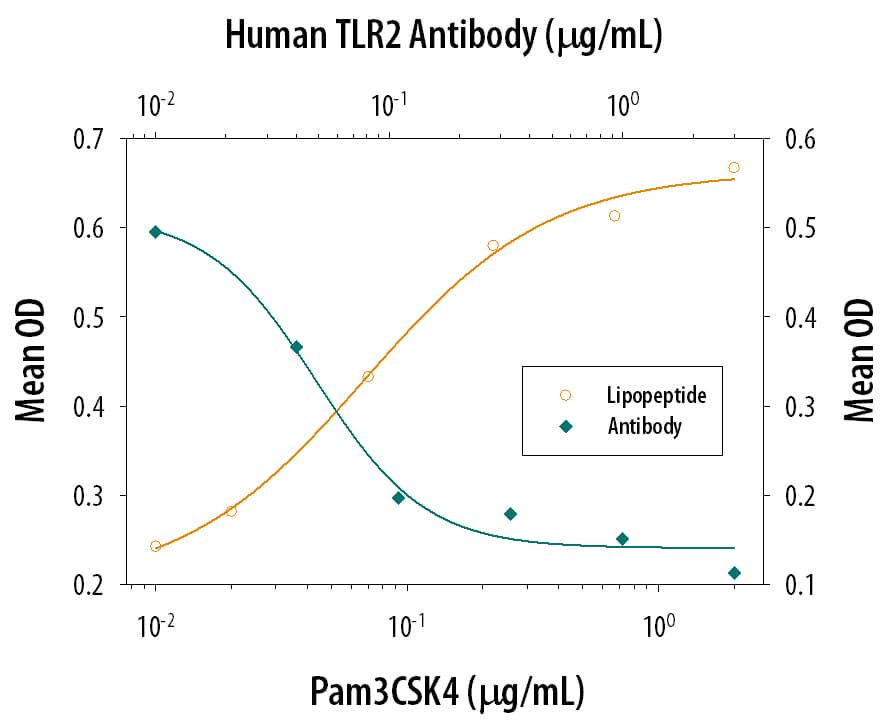Human TLR2 Antibody
R&D Systems, part of Bio-Techne | Catalog # MAB2616


Key Product Details
Species Reactivity
Validated:
Cited:
Applications
Validated:
Cited:
Label
Antibody Source
Product Specifications
Immunogen
Accession # O60603
Specificity
Clonality
Host
Isotype
Endotoxin Level
Scientific Data Images for Human TLR2 Antibody
IL‑8 Secretion Induced by Pam3CSK4and Neutralization by Human TLR2 Antibody.
The synthetic tripalmitoylated lipopeptide Pam3CSK4stimulates IL-8 secretion in the HEK293 human embryonic kidney cell line transfected with human TLR2, in a dose-dependent manner (orange line), as measured by the Human CXCL8/IL-8 Quantikine ELISA Kit (Catalog # D8000C). IL-8 secretion elicited by Pam3CSK4(0.5 µg/mL) is neutralized (green line) by increasing concentrations of Mouse Anti-Human TLR2 Monoclonal Antibody (Catalog # MAB2616). The ND50 is typically 0.03-0.15 µg/mL.Detection of TLR2 in Human Monocytes by Flow Cytometry.
Human whole blood monocytes were stained with Mouse Anti-Human TLR2 Monoclonal Antibody (Catalog # MAB2616, filled histogram) or isotype control antibody (Catalog # MAB0041, open histogram), followed by Phycoerythrin-conjugated Anti-Mouse IgG F(ab')2Secondary Antibody (Catalog # F0102B).Applications for Human TLR2 Antibody
CyTOF-ready
Flow Cytometry
Sample: Human whole blood monocytes
Neutralization
Reviewed Applications
Read 3 reviews rated 4.7 using MAB2616 in the following applications:
Formulation, Preparation, and Storage
Purification
Reconstitution
Formulation
Shipping
Stability & Storage
- 12 months from date of receipt, -20 to -70 °C as supplied.
- 1 month, 2 to 8 °C under sterile conditions after reconstitution.
- 6 months, -20 to -70 °C under sterile conditions after reconstitution.
Background: TLR2
Human toll-like receptor (TLR) family includes ten members that activate the innate immune response via an ability to recognize molecular structures found in a variety of microbial pathogens (1‑3). All TLR family members are type I transmembrane proteins with a large number of extracellular leucine-rich repeats (LRRs) and a cytoplasmic Toll/IL-1 receptor (TIR) domain. Human TLR2 is synthesized as a 784 amino acid (aa) precursor (2) that contains a signal sequence (aa 1-18), an extracellular domain (aa 19-588) with approximately 20 LRRs, a transmembrane segment (aa 589-609), and a cytoplasmic TIR domain (aa 610-784). The receptor is expressed on a number of cell types including monocytes, dendritic cells, neutrophils, B cells endothelial cells, and hepatocytes (1, 2, 4). TLR2 functions as part of a heterodimeric complex with either TLR1 or TLR6, and possibly other co-receptors (1). These complexes recognize lipoproteins and glycolipids from gram-positive and gram-negative bacteria as well as mycoplasma and yeast. TLR2/TLR1 heterodimers bind triacylated lipopeptides, while the TLR2/TLR6 heterodimer preferentially recognizes diacylated lipopeptides (5). Upon ligand recognition, TLR2 delivers an activating signal via the associated adapter molecules, MyD88 and TIRAP (1, 6). TLR2 signaling results in dendritic cell maturation characterized by increased surface expression of class II MHC and the T cell costimulators, CD80 and CD86 (1, 2). Activation via TLR2 also results in production of a number of pro-inflammatory cytokines including TNF-alpha, IL-2, IL-6, IL-12, and MIP-2 (1-3).
References
- Wetzler, L. (2003) Vaccine 21:S2/55.
- Kirschning, C. and R. Schumann (2002) Curr. Top. microbiol. Immunol. 270:121.
- Netea, M. et al. (2004) J. Leukoc. Biol. 75:749.
- Flo, T. et al. (2001) J. Leukoc. Biol. 69:474.
- Akira, S. (2003) Curr. Opin. Immunol. 15:5.
- Yamamoto, M. et al. (2002) Nature 420:324.
Long Name
Alternate Names
Gene Symbol
UniProt
Additional TLR2 Products
Product Documents for Human TLR2 Antibody
Product Specific Notices for Human TLR2 Antibody
For research use only
